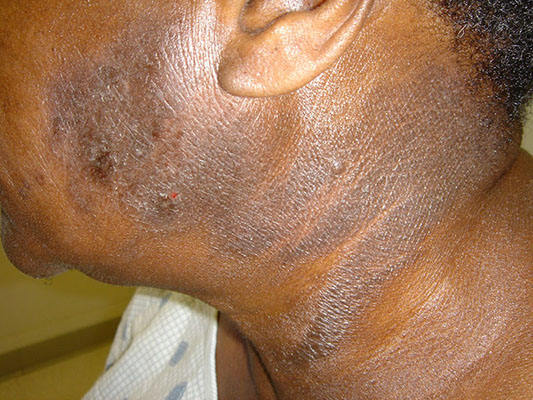Written by Dr. Pradeep
OVERVIEW
Photosensitive dermatitis is a condition where a person’s skin develops unusual reactions, such as eczematous eruptions, in response to UV radiation, visible light, or both in sunlight and artificial light sources. Photosensitive refers to a reaction to light, while dermatitis is the term for inflammation of the skin.
Some people may also refer to photosensitive dermatitis as photosensitivity, photodermatosis, photodermatitis, sun allergy, photoallergy, or chronic actinic dermatitis.
There are currently no data on the incidence and prevalence of photosensitive dermatitis, as diagnoses are rareTrusted Source. This is likely due to potential misdiagnoses — it may start as atopic dermatitis without any signs of photosensitivity, or people may associate it with sunburns or excessive sun exposure.

SYMPTOMS AND CAUSES
Experts can characterize photosensitive dermatitis by “photodistributed” lesions and skin eruptions. These appear at sun-exposed parts of the skin, such as the outer part of the arms and hands, the chest, and the back and side of the neck.
Areas that typically do not receive sun exposure, such as the folds of the upper eyelids, the webspaces between fingers, and the shadowed areas under the nose and chin, do not usually develop these lesions.
The condition may also resemble an exaggerated form of sunburn, but the reactions occur even with less intense light exposure. The appearance of symptoms following light exposure may also be instant or delayed.
Causes
In photosensitive dermatitis, a phototoxic or photoallergic reaction causes the individual’s abnormal response to sunlight. Both reactions occur due to topical treatments or medications in the person’s body.
Phototoxic reactions
Phototoxic reactions are a common type of photosensitivity reaction. Here, a person takes medications, such as systemic agents, or applies skin care products that contain photosensitizing agents, which react to UV light exposure.
Skin damage looks and feels similar to sunburns and rashes and is well-defined. The skin reaction often appears within minutes to hours, but it may take days in some cases. With a sufficient chemical dose and light exposure, it can happen to anyone.
Photoallergic reactions
Less commonly, and in contrast to phototoxic reactions, photoallergic reactions involve immune hypersensitivity. Here, the UV light interacts and changes the structure of a chemical or an antigen after a person takes it or applies it to their skin.
The immune system detects the change, sees it as a threat, and forms antibodies to attack it. Photodistributed rashes, blisters, and oozing lesions may appear a few days after light exposure.
Besides chemical and drug-induced reactions, photosensitive dermatitis may also be hereditary or due to an underlying medical condition. A 2019 studyTrusted Source suggests that older adults are at risk for developing photosensitivity reactions. It also notes that more than one-fifth of their medications are potentially phototoxic, photoallergic, or both.
Diagnosis
People may not directly associate the appearance of eruptions or lesions on their skin with light exposure, especially if the reaction is not instant.
To confirm the diagnosis of photosensitive dermatitis, doctors will ask questions about previous sun exposure, exposure to photosensitizing agents, family history, and any other symptoms. They will also examine the skin and look at the distribution of skin lesions to help rule out other forms of photosensitivity. Further evaluations include phototesting and photopatch testing.
In phototesting, an individual’s skin receives increasing doses of UVA and UVB light exposure. In photopatch testing, medical practitioners apply two sets of photoallergen. The practitioners will irradiate one allergen and use the other as a control. A dermatologist can also perform a skin biopsy and other laboratory investigations.
The evaluation will define the specific type of photodermatoses affecting an individual. It also aims to rule out other conditions, such as porphyria, systemic lupus erythematosus, and pellagra. Blood tests including a complete blood count can also help rule out other conditions.
Treatments
The main form of treatment for photosensitive dermatitis will typically include prevention methods, such as using sun protection, avoiding contact with any known allergens, and stopping any photosensitizing drugs if possible. This may involve staying inside, fully covering the skin, using broad-spectrum sunscreens, and taking photoprotective medications.
To treat any eczematous reactions, doctors will likely suggest similar options to other forms of eczema, such as emollients and topical steroids. In cases of severe dermatitis, doctors may suggest stronger medications, such as oral corticosteroids or immunosuppressive agents.
Related Procedures

Leg Hair Removal

Loyalty Rewards

Body Hair Removal

Facial Hair Removal

For Dark Skin

Threading

Alexandrite Laser

Electrolysis

